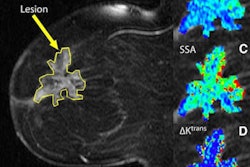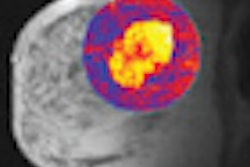CHICAGO - Using breast MRI before surgically treating ductal carcinoma in situ (DCIS) makes for more accurate staging, according to research presented Tuesday at the American Roentgen Ray Society (ARRS) annual meeting in Chicago.
Dr. Patricia Somerville, of Elizabeth Wende Breast Care, and colleagues regularly use breast MRI to assess the extent of cancer to help plan treatment, she said. In addition, it's also their protocol to perform targeted ultrasound after most MRI scans.
The study compared presurgical MRI findings to DCIS core biopsy results and included 278 breast MRI exams performed between 2005 and 2009. Somerville's team acquired images on one of two 1.5-tesla units, using one scanner from GE Healthcare for the first year of the study and a second unit from Siemens Healthcare for the remaining years.
"In our review, we looked at the extent of known cancer, suspicious MRI findings, how the findings impacted surgical management, and the overall diagnostic performance of breast MRI," Somerville said.
Somerville's team categorized breast MRI's diagnostic performance into three groups:
- "Correct": MRI findings correlated with core biopsy and surgical pathology results
- "Overestimate": MRI identified abnormalities that were found to be benign on core biopsy
- "Underestimate": MRI did not identify cancers subsequently found on surgical pathology reports
The researchers found that MRI matched surgical pathology results 87% of the time, overestimated cancer 11% of the time, and underestimated cancer 3% of the time, Somerville said.
"Of the seven cancers missed by MRI, five were distant DCIS and two were invasive carcinomas," she said.
MRI found abnormalities that required further attention in 70 out of the 278 patients who presented for presurgical exams after a core biopsy of DCIS, Somerville said. Of these 70 women, 10 refused further workup and chose to have mastectomies.
The remaining 60 women with MRI-identified abnormalities underwent 64 core biopsies (22 ultrasound, 37 MRI, and five stereotactic). These biopsies found additional sites of cancer in 30 women, and the women's surgical management changed as a result. Twenty-five of them had mastectomies, while five had larger lumpectomies than originally planned, according to Somerville.
Also, within the group of 60 women, the researchers found a subset of six who had multiple calcification sites. Somerville's team used MRI as a way to try to decrease the number of core biopsies the women would need to undergo. All six were found to have cancer at subsequent biopsy; five had mastectomies and one had a lumpectomy.
Overall, the study showed that breast MRI is helpful in surgical planning for DCIS, Somerville said.
"In 278 patients, 25% required further investigation, yielding 30 unknown cancers and affecting surgical planning in 10% of patients [included in the study]," she said.



















